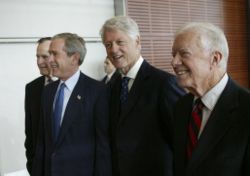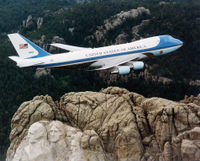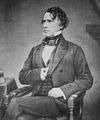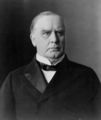President of the United States
2007 Schools Wikipedia Selection. Related subjects: Politics and government
- This article is about the office "President of the United States". For other uses, see The Presidents of the United States of America.
- For the film, see The American President (film).
- See also: List of Presidents of the United States and United States Presidential trivia.
- For the film, see The American President (film).

The President of the United States of America (often abbreviated POTUS) is the head of state of the United States. The office of President was established upon the ratification of the United States Constitution in 1788 and the first president took office in 1789. The President serves as chief executive and head of the executive branch of the United States government. Article Two of the United States Constitution establishes the President as the Commander-in-Chief of the armed forces and enumerates powers specifically granted to the President, including the power to sign into law bills passed by both houses of the Legislature, to create a Cabinet of advisors, to grant pardons or reprieves, and, with the " advice and consent" of the United States Senate, to make treaties and appoint officers, ambassadors, and judges (to include Justices of the Supreme Court). Article Two also defines a Presidential term at four years; subsequently, the Twelfth Amendment (1804) revised the procedure for electing the President and the Twenty-second Amendment (1951) established Presidential term limits.
Before the 1788 ratification of the Constitution, there was no comparable figure with executive authority. Individuals who presided over the Continental Congress during the Revolutionary period and under the Articles of Confederation had the title " President of the United States of America in Congress Assembled", often shortened to "President of the United States." They had no important executive power. The President's executive authority, tempered by the checks and balances of the Judicial and Legislative branches of the Federal Government, was designed to solve several political problems faced by the young nation and to anticipate future challenges, while still preventing the rise of an autocrat over a nation wary of royal authority.
The United States was the first nation to create the office of President as the head of state in a modern republic, and today the presidential system of government is used in several countries throughout the world. As of 2006, there have been forty-three Presidents of the United States. The first President of the United States was George Washington, and the 43rd and current President of the United States is George W. Bush. From the early 20th Century, the United States' status as a superpower has led the American President to be one of the world's best-known public figures. "The leader of the free world" was a common phrase describing the President during the Cold War, and since the collapse of the Soviet Union, the President of the United States has often been described as "the most powerful person on Earth."
Origin
The Treaty of Paris (1783) left the United States independent and at peace but with an unsettled governmental structure. The Second Continental Congress had drawn up Articles of Confederation in 1777, describing a permanent confederation but granting to the Congress--the only federal institution--little power to finance itself or to ensure that its resolutions were enforced. In part this reflected the anti-monarchy view of the Revolutionary period, and the new American system was explicitly designed to prevent the rise of an American tyrant to replace the British King.
However, during the economic depression that followed the Revolutionary War the viability of the American government was threatened by political unrest in several States, efforts by debtors to use popular government to erase their debts, and the apparent inability of the Continental Congress to redeem the public obligations incurred during the war. The Congress also appeared unable to become a forum for productive cooperation among the States encouraging commerce and economic development. In response a Constitutional Convention was convened, ostensibly to reform the Articles of Confederation but that subsequently began to draft a new system of government that would include greater executive power while retaining the checks and balances thought to be essential restraints on any imperial tendency in the office of the President.
General description
Article Two of the United States Constitution, coupled with several articles of amendment, establish the requirements one must meet in order to become President, as well as the term of office, method of election, and powers.
Requirements for holding office
Section One of Article II of the U.S. Constitution states that the President must be a natural born citizen of the United States (or a citizen of the United States at the time the U.S. Constitution was adopted), at least 35 years of age, and a resident of the United States for at least fourteen years.
There is currently debate concerning the definition of " natural born citizen." The main focus of this debate is whether or not children born to Americans overseas be considered eligible for the Presidency. Several main candidates have sought the office who were born outside the United States (e.g., George Romney was born in Mexico to U.S. parents, Barry Goldwater was born in Arizona while it was still a U.S. territory, and John McCain was born in the Panama Canal Zone to U.S. parents). Barry Goldwater's case among these three is unique in that although he was born outside the United States, Arizona was later admitted as a state. None of these candidates were elected, so the issue was never fully addressed.
The origin of the " natural born citizen" clause can be traced to a July 25, 1787, letter from John Jay to George Washington, presiding officer of the Constitutional Convention. John Jay wrote: "Permit me to hint, whether it would be wise and seasonable to provide a strong check to the admission of Foreigners into the administration of our national Government; and to declare expressly that the Commander in Chief of the American army shall not be given to nor devolve on, any but a natural born Citizen." There was no debate, and this qualification for the office of the Presidency was introduced by the drafting Committee of Eleven, and then adopted without discussion by the Constitutional Convention.
The requirements for citizenship and the very definition thereof have changed since the Constitution was ratified in 1788. Congress first extended citizenship to children born to U.S. parents overseas on March 26, 1790, under the first naturalization law: "And the children of citizens of the United States that may be born beyond sea, or outside the limits of the United States, shall be considered as natural born citizens." This was addressed by the U.S. Supreme Court in the Dred Scott case as a form of naturalization. The Dred Scott case, however, was overturned by the Fourteenth Amendment in 1868. The Fourteenth Amendment mentions two types of citizenship: citizenship by birth and citizenship by law (naturalized citizens): "All persons born or naturalized in the United States, and subject to the jurisdiction thereof, are citizens of the United States and of the State wherein they reside."
All persons born in the United States are citizens by birth. There is some debate over whether other persons with citizenship can also be considered citizens by birth, or whether they should all be considered citizens by law (thus "naturalized"). Current US statutes define certain individuals born overseas as citizens by birth. One side of the argument interprets the Constitution as meaning that a person either is born in the United States or is a naturalized citizen. Thus, to be a "natural born citizen," a person must be born in the United States; otherwise, they are citizens by law and are naturalized. To others, the statute that grants citizenship to American children born overseas exempts them from the term "naturalized" and thus, as with the 1790 law, they are to be considered "natural born citizens" eligible for the Presidency. Examples of persons who become citizens at birth (whether "naturalized" or "natural born") would include: birth to Americans overseas, or birth on U.S. soil, territories, or military bases overseas.
Term of office

The President and Vice President serve a term of office of four years. The Twenty-second Amendment (which took effect in 1951) provides that no one may be elected to the office more than twice, and that no one may be elected President more than once who has held the office of (or acted as) President for more than two years of another's term (thus a person may hold the office of President no longer than ten years--two four-year terms and one term less than two years having been a vice president who succeeded to the Presidency). Prior to the ratification of this amendment, and following the precedent set by George Washington, an unofficial limit of two terms was generally observed, with the only exceptions being Theodore Roosevelt, who ran unsuccessfully for a third nonconsecutive term (although his first term was to finish the term of president William McKinley, who was assasinated- hence he was only elected once, for his second term), and Franklin D. Roosevelt, who was elected 4 times, served three full terms and died in his fourth after just over 12 years in office. Since the amendment went into effect, three Presidents have served two full terms: Dwight Eisenhower, Ronald Reagan, and Bill Clinton. Richard Nixon was elected to a second term but resigned before completing it. Current President George W. Bush will become the fourth should he complete his current term, on 20 January 2009. Lyndon B. Johnson was the only president since the ratification of the amendment to have been eligible to have served more than 2 terms, having served only 14 months of John F. Kennedy's term after becoming president following the latter's assassination. Harry S. Truman was also eligible for an unlimited amount of terms as the 22nd specifically states it both did not apply to the current term of the president in office upon its ratification (Truman) or "to any person holding the office of President when this Article was proposed by the Congress" (Truman). He briefly sought re-election in 1952, but withdrew after losing the New Hampshire primary.
Election
Presidents and Vice Presidents of the United States are elected every four years indirectly through the United States Electoral College. They are the only nationally-elected offices in the United States, since executive officers and judges are appointed, United States Senators are elected at the state level, and United States Representatives are elected at the district level.
On election day, the voting public selects its preferred candidate, usually by voting for a slate of electors put forward by the candidate's party. The ballots for each voting citizen typically has the names of the candidates for President and Vice President (running together on a ticket), and votes for those individuals translate at the state level into votes for the electors chosen from their respective parties. Although State Legislatures have the constitutional power to appoint slates of electors, all fifty states have established popular election of presidential electors. In December, following the general election, Electors gather at their respective State capitals to cast their ballots, which are then transmitted to Congress under the care of the sitting Vice President of the United States. Originally, under Article 2, the electors cast two votes for the office of President, the individual with the most votes becoming President, the runner up becoming Vice President. This changed with the 12th amendment, with each elector casting one vote for President and one vote for Vice President. The ballots are counted and certified in January before both houses of Congress. Should a candidate for either President or Vice President fail to achieve a majority of votes, the United States House of Representatives (voting by state) chooses the next president from among the candidates while the United States Senate (voting normally) selects the vice president.
Powers
The President, according to the Constitution, must "take care that the laws be faithfully executed." To carry out this responsibility, he has many powers, most of which are subject to or checked by Congressional power. He presides over the executive branch of the federal government; a vast organization of about 4 million people, including 1 million active-duty military personnel, of whom he is Commander in Chief.
The Federalist Papers #69 states, "In most of these particulars, the power of the President will resemble equally that of the king of Great Britain and of the governor of New York. The most material points of difference are these: First. The President will have only the occasional command of such part of the militia of the nation as by legislative provision may be called into the actual service of the Union. The king of Great Britain and the governor of New York have at all times the entire command of all the militia within their several jurisdictions. In this article, therefore, the power of the President would be inferior to that of either the monarch or the governor. Secondly. The President is to be commander-in-chief of the army and navy of the United States. In this respect his authority would be nominally the same with that of the king of Great Britain, but in substance much inferior to it. It would amount to nothing more than the supreme command and direction of the military and naval forces, as first General and admiral of the Confederacy; while that of the British king extends to the DECLARING of war and to the RAISING and REGULATING of fleets and armies, all which, by the Constitution under consideration, would appertain to the legislature". However, his control over these tools of state are checked by Congress' power "to make Rules for the Government and Regulation for the land and naval Forces" ( Article I, Section 8).
As President-elect, he will make as many as 6,000 appointments in addition to those that must be made during his term proper (including appointments to the federal judiciary), but the Senate must consent to all appointments, except those of "inferior officers" that Congress has vested exclusively in him, the courts, or the heads of departments. He may make temporary appointments without the advice and consent of the Senate if the Senate is in recess, but such appointments expire at the end of the next session of the Senate.
While he may not personally initiate legislation, the President may veto any legislation passed by Congress. Such a veto may be overturned by a two-thirds majority vote in each House. He may make treaties, but two-thirds of the Senate must ratify the treaty. He is also required by the Constitution to give Congress information on the State of the Union and propose measures for their consideration.
According to political scientist Richard Neustadt, "Presidential power is the power to persuade and the power to persuade is the ability to bargain." The President's constitutional domestic power is limited, and so, according to Neustadt, successful bargaining with Congress is usually essential to Presidential success.
The Campaign
The modern presidential campaign begins before the primary elections, which the two major political parties use to clear the field of candidates in advance of their national nominating conventions, where the most successful candidate is made the party's nominee for President. The party's presidential candidate chooses a vice presidential nominee and this choice is rubber-stamped by the convention. Also, the party establishes a platform on which to base its campaign. Although nominating conventions have a long history in the United States, their substantive importance in the political process has greatly diminished; however, they remain important as a way of energizing the parties for the general election and focusing the public's attention on the nominees.
Nominees participate in nationally televised debates, and while the debates are usually restricted to the Democratic and Republican nominees, third party candidates may be invited (such as Ross Perot in the 1992 debates). Nominees campaign across the country to explain their views, convince voters, and solicit contributions. Much of the modern electoral process is concerned with winning swing states through frequent visits and mass media advertising drives.
Salary
| Presidential pay history | ||
| Date established | Salary | Salary in 2005 dollars |
|---|---|---|
| September 24, 1789 | $25,000 | $531,000 (1789) |
| March 3, 1873 | $50,000 | $811,000 (1873) |
| March 4, 1909 | $75,000 | $1,607,000 (1909) |
| January 19, 1949 | $100,000 | $820,000 (1949) |
| January 20, 1969 | $200,000 | $1,067,000 (1969) |
| January 20, 2001 | $400,000 | $441,000 (2001) |
The First U.S. Congress voted to pay George Washington a salary of $25,000 a year (about $531,000 in 2005 terms) — a significant sum in 1789. Washington, already a wealthy man, refused to accept his salary. Similarly, John F. Kennedy donated his salary to charities.
Traditionally, the President is the highest-paid government employee. Consequently, the President's salary serves as a traditional cap for all other federal officials, such as the Chief Justice. A raise for 2001 was approved by Congress and President Bill Clinton in 1999 because other officials who receive annual cost-of-living increases had salaries approaching the President's. Consequently, to raise the salaries of the other federal employees, the President's salary had to be raised as well. The President's monetary compensation is minuscule in comparison to the CEOs of most Fortune 500 companies and comparable to that of certain kinds of professionals e.g. attorneys and physicians in some parts of the United States. Overall the vast majority of US presidents were very affluent upon entering office and thus were not dependent on the salary.
Privileges of office

The President is entitled to use the White House as his living and working quarters, and its entire staff and facilities, including medical care, kitchen, housekeeping and security staff. While traveling, the President is able to conduct the functions of the office from one of two custom-built Boeing 747 aircraft popularly known as " Air Force One." The President also utilizes a United States Marine Corps helicopter, designated " Marine One" when the President is aboard. Similarly, " Navy One" and " Coast Guard One" are the call signs used if the President is aboard an aircraft belonging to these services. For ground travel, the President uses an armored Presidential limousine, currently a heavily modified Cadillac DTS.
Secret Service
The sitting President and his family are always protected by a United States Secret Service detail, and until 1997, all former Presidents and their families were protected by the Secret Service until the President's death. The last President to have lifetime Secret Service protection is Bill Clinton; George W. Bush and all subsequent Presidents will be protected by the Secret Service for a maximum of ten years after leaving office.
Succession
Article 2 of the Constitution provides that the Vice President takes the place of President if the office were to become vacant. More detail is prescribed in the 20th and 25th amendments, and later extend the line of succession further.
The only President to be neither elected to the office of President nor Vice President was Gerald Ford who was appointed by Richard Nixon and confirmed after his Vice President Spiro Agnew resigned in 1973]]. Nixon later resigned and Ford succeeded to the Presidency. Ford was never subsequently elected.
Office-holders
|
|
|
|
|
|
|
|
|
|
|
|
|
|
|
|
|
|
|
|
|
|
|
|
|
|
|
|
|
|
|
|
|
|
|
|
|
|
|
|
|
|
|
|
|
|
|
|
|
|
|
|
|
|
*Note: Cleveland was elected twice nonconsecutively, changing the numbers of all presidents after him, starting with McKinley. Thus, George W. Bush is the 43rd president although he is the 42nd person to hold the office.
The Masonic American Presidents
Fifteen U.S. Presidents are definitely known to have been Freemasons: George Washington, James Monroe, Andrew Jackson, James Polk, James Buchanan, Andrew Johnson, James Garfield, William McKinley, Theodore Roosevelt, William Howard Taft, Warren G. Harding, Franklin D. Roosevelt, Harry S. Truman, Lyndon Johnson and Gerald Ford.
James Madison was probably a Freemason, but there is no surviving documentary proof of it. Lyndon Johnson took the Entered Apprentice degree in 1937 but never continued to become a Master Mason. In 1988, Ronald Reagan was made an honorary Scottish Rite Mason jointly by the Northern and Southern Masonic Jurisdictions of the Scottish Rite, but he never received the first three degrees of Masonry and had no privileges of Masonic membership. Bill Clinton joined the Masonic Order of DeMolay as a teenager but never went on to become a Freemason.
Abraham Lincoln applied for membership in a lodge in Springfield, Illinois, shortly after he was nominated for the Presidency in 1860. Lincoln withdrew his application because he was concerned that it would be construed as a political ploy to win votes. Lincoln told the lodge that he intended to resubmit his application again when he returned to private life.
Considering the most important Scholar Rankings (Schlesinger 1948 poll rank, Schlesinger 1962 poll rank, 1982 Murray-Blessing survey of 846 historians, Chicago Tribune 1982 poll rank, Siena 1982 poll rank, Siena 1990 poll rank, Siena 1994 poll rank, Ridings- McIver 1996 poll rank, CSPAN 1999 poll rank, Wall Street Journal 2000 poll rank, Siena 2002 poll rank, Wall Street Journal 2005 poll rank), the average ranking of the Masonic U.S. Presidents is 15.7, which would place them among the best third of their class (top 36 percentile).
Life after the presidency
Presidents continue to enjoy benefits after leaving office, including free mailing privileges, free office space, daily CIA briefings, a diplomatic passport, Secret Service protection (see above), and budgets for office help and staff assistance. After Harry S Truman (1958) presidents received a pension after they left office, and since the presidency of Herbert Hoover, presidents have received funding from the National Archives and Records Administration to establish their own presidential library, a repository for preserving and making available their papers, records, and other historical materials.
Former presidents continue to be important national figures, and in some cases go on to successful post-presidential careers. Notable examples have included William Howard Taft's tenure as Chief Justice of the United States, Herbert Hoover's work on government reorganization after World War II, Jimmy Carter's current career as a global human rights campaigner and best-selling writer, and most recently George H. W. Bush and Bill Clinton's combined effort to appeal for donations from Americans after the 2004 Indian Ocean earthquake and Hurricane Katrina in 2005. Andrew Johnson was elected to the Senate after his term was over, and John Quincy Adams served in the House of Representatives. John Tyler served in the provisional Confederate States Congress during the Civil War, and was elected to the official Confederate Congress but died before it convened.
Grover Cleveland, whose bid for reelection failed in 1888, was elected President again four years later in 1892.









































